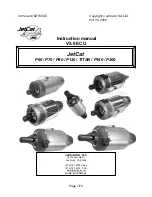
14
16
when you filled the fuel tank.
Fuel system damage or engine performance problems resulting from neglected storage preparation are not
covered under Warranty.
11.1.4 ADDING A GASOLINE STABILIZER TO EXTEND FUEL STORAGE LIFE
When adding a gasoline stabilizer, fill the fuel tank with fresh gasoline. If only partially filled, air in the tank will
promote fuel deterioration during storage. If you keep a container of gasoline for refueling, be sure that it
contains only fresh gasoline.
1. Add gasoline stabilizer by following the manufacturer's instructions.
2. After adding a gasoline stabilizer, run the engine outdoors for 10 minutes to be sure that treated gasoline
has replaced the untreated gasoline in the carburetor.
11.1.5 DRAINING THE FUEL TANK AND CARBURETOR
WARNING:
Gasoline is highly flammable and explosive, and you can be burned or seriously injured when
handling fuel. Stop engine and keep heat, sparks, and flame away. Refuel only outdoors. Wipe up spills
immediately.
1. Place an approved gasoline container below the carburetor, and use a funnel to avoid spilling fuel.
2. Remove the drain bolt, and then move the fuel valve lever to the
“ON” position.
3. After all the fuel has drained into the container; reinstall the drain bolt and washer. Tighten the drain bolt
securely. (See Fig. 13)
Fig. 13
A bolt
B spring
5 carburetor
11.1.6 ENGINE OIL
1. Change the engine oil.
2. Remove the spark plug.
3. Pour a tablespoon (5 - 10 cc) of clean engine oil into the cylinder.
4. Pull the recoil starter several times to distribute the oil.
5. Reinstall the spark plug.
11.1.7 CLEAN FUEL STRAINER
WARNING:
Gasoline is extremely flammable and is explosive under certain conditions Do not smoke or
allow flames or sparks in the area.
1. Remove the fuel strainer from the fuel tank and fuel line.
2. Clean the fuel strainer (remove dirt which has accumulated on the mesh, and check that the mesh is not
broken anywhere).
3. Reinstall the fuel strainer (A) and fuel line. (See Fig. 14)



































